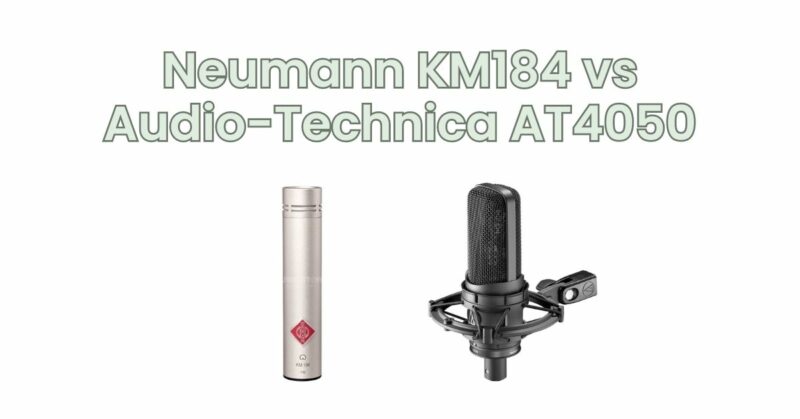Small diaphragm condenser microphones are widely used in recording studios and live performances to capture detailed and accurate sound reproduction. The Neumann KM184 and Audio-Technica AT4050 are two popular options that have gained recognition for their exceptional sonic qualities. In this article, we will compare the Neumann KM184 and Audio-Technica AT4050, highlighting their key features, sonic characteristics, and helping you determine which microphone is best suited for your recording needs.
- Neumann KM184:
- Audio-Technica AT4050:
Neumann KM184: The Neumann KM184 is known for its pristine sound quality and exceptional detail retrieval. Here are some key features of the Neumann KM184:
- Sound Quality: The KM184 offers a transparent and natural sound reproduction with a slight emphasis on the midrange. It captures the nuances and subtleties of acoustic instruments, vocals, and ensembles with exceptional clarity and accuracy. The microphone’s extended frequency response ensures precise representation of both high and low frequencies.
- Compact Design and Versatility: The KM184 features a compact and lightweight design, making it easy to position in various recording setups. Its cardioid polar pattern provides focused sound capture while minimizing off-axis noise and room reflections. It is often used for stereo miking techniques, such as coincident and spaced pair configurations.
- Low Self-Noise and High SPL Handling: The KM184 has a low self-noise level, allowing for pristine recordings even in quiet and detailed sound sources. It can handle high sound pressure levels (SPL) without distortion, making it suitable for close-miking loud instruments such as drums and guitar amplifiers.
Audio-Technica AT4050: The Audio-Technica AT4050 is a versatile and well-regarded microphone in the professional audio industry. Here are some key features of the Audio-Technica AT4050:
- Sound Quality: The AT4050 offers a balanced and natural sound reproduction with a smooth and extended frequency response. It delivers accurate and transparent audio capture across a wide range of sources, making it suitable for vocals, acoustic instruments, and percussion.
- Multiple Polar Patterns: One of the notable features of the AT4050 is its ability to switch between three polar patterns: cardioid, omnidirectional, and figure-8. This versatility allows for flexible recording techniques and the ability to capture sound from different directions with precision.
- Robust Build and Versatility: The AT4050 is built with durability in mind, featuring a robust construction and a shock-mount system that effectively reduces handling noise. It performs well in various recording scenarios, whether in the studio or on stage, making it a versatile tool for audio professionals.
Choosing the Right Microphone: When deciding between the Neumann KM184 and Audio-Technica AT4050, consider the following factors:
- Sound Preference: Both microphones offer high-quality sound reproduction, but they have slightly different tonal characteristics. The KM184 is known for its transparent and detailed sound, while the AT4050 offers a balanced and smooth response. Consider the sound signature that best suits your recording applications and personal preferences.
- Polar Patterns: The AT4050’s ability to switch between multiple polar patterns provides greater versatility for capturing different sound sources and recording techniques. If you require the flexibility to experiment with various polar patterns, the AT4050 might be the preferred choice.
- Budget: Budget is an important consideration when investing in a microphone. The Neumann KM184 is typically priced higher than the Audio-Technica AT4050. Determine your budget and evaluate the overall value and features offered by each microphone.
Both the Neumann KM184 and Audio-Technica AT4050 are highly regarded small diaphragm condenser microphones that excel in capturing the nuances and details of sound sources. The KM184 offers pristine transparency and detail retrieval, while the AT4050 provides a balanced and versatile sound reproduction with switchable polar patterns. Consider your specific recording needs, sound preferences, and budget to make an informed decision. Regardless of your choice, both microphones have earned their place in professional audio applications and will undoubtedly enhance the quality of your recordings.


